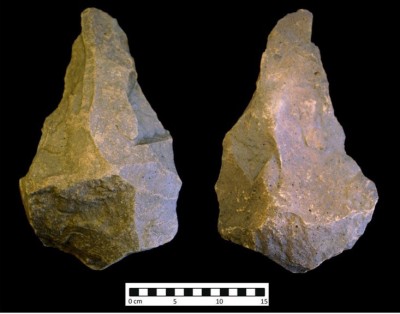New Publication: The Wadi Dabsa Handaxe

Antiquity journal has just published the first results of the Wadi Dabsa site, one of the largest concentrations of Palaeolithic material discovered during the DISPERSE surveys in SW Arabia
The publication is entitled: A large handaxe from Wadi Dabsa and early hominin adaptations within the Arabian Peninsula, by Frederick W.F. Foulds, Andrew Shuttleworth, Anthony Sinclair, Abdullah M. Alsharekh, Saud al Ghamdi, Robyn H. Inglis and Geoff Bailey. Antiquity, Volume 91, Issue 360, December 2017, pp. 1421-1434.
The site was first discovered by Robyn Inglis in 2015 and comprises a tufa-filled basin bounded by volcanic lava flows, several kilometres inland from the Red Sea coastline near the town of Al Birk. Further details of the site can be found in the Preliminary Field Report of 2015.
The Antiquity paper focuses on the Acheulean material from the site and in particular on a very large bifacially worked handaxe some 27 cm long and 3.6 kg in weight found on the edge of a lava flow on the north side of the basin, and on its possible function. Handaxes of this size are known from Acheulean assemblages in Africa and Europe, but they are very rare, and the Dabsa specimen is the first recorded in the Arabian Peninsula. The artefact, like most of the Dabsa material, is a surface find, so that its precise age cannot yet be determined except within a very broad time range of the Pleistocene. The material in the basin is a palimpsest that most probably represents repeated visits to an unusually attractive and well-watered basin over many tens of millennia.
More recent field investigations have found some material in situ in stratified deposits including a smaller bifacial artefact partly encrusted with tufa. Geochronological and palaeoenvironmental analysis of the tufa and the lava flows is ongoing.






